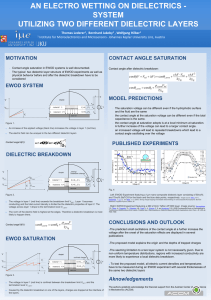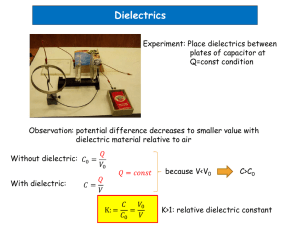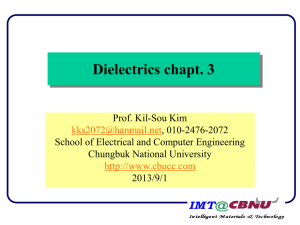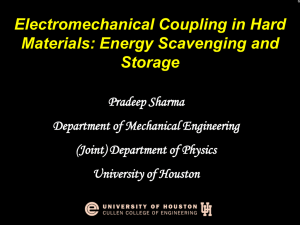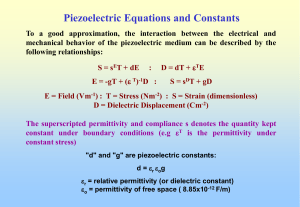Dielectric behavior - School of Engineering and Applied Sciences
advertisement
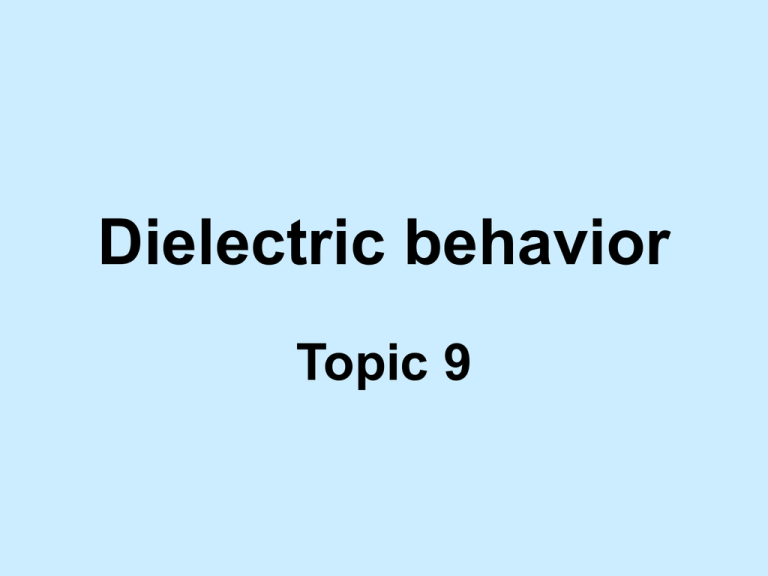
Dielectric behavior Topic 9 Reading assignment • Askeland and Phule, The Science and Engineering of Materials, 4th Ed., Sec. 18-8, 18-9 and 18-10. • Shackelford, Materials Science for Engineering, Sec. 15.4. • Chung, Composite Materials, Ch. 7. Insulators and dielectric properties • Materials used to insulate an electric field from its surroundings are required in a large number of electrical and electronic applications. • Electrical insulators obviously must have a very low conductivity, or high resistivity, to prevent the flow of current. • Porcelain, alumina, cordierite, mica, and some glasses and plastics are used as insulators. Dielectric strength • Maximum electric field that an insulator can withstand before it loses its insulating behavior • Lower for ceramics than polymers • Dielectric breakdown - avalanche breakdown or carrier multiplication Polarization in dielectrics • Capacitor – An electronic device, constructed from alternating layers of a dielectric and a conductor, that is capable of storing a charge. These can be single layer or multi-layer devices. • Permittivity - The ability of a material to polarize and store a charge within it. • Linear dielectrics - Materials in which the dielectric polarization is linearly related to the electric field; the dielectric constant is not dependent on the electric field. • Dielectric strength - The maximum electric field that can be maintained between two conductor plates without causing a breakdown. Polarization mechanisms in materials: (a) electronic, (b) atomic or ionic, (c) high-frequency dipolar or orientation (present in ferroelectrics), (d) low-frequency dipolar (present in linear dielectrics and glasses), (e) interfacial-space charge at electrodes, and (f ) interfacial-space charge at heterogeneities such as grain boundaries. A charge can be stored at the conductor plates in a vacuum (a). However, when a dielectric is placed between the plates (b), the dielectric polarizes and additional charge is stored. ©2003 Brooks/Cole, a division of Thomson Learning, Inc. Thomson Learning™ is a trademark used herein under license. Q Do = , A V = , d Do = o o = 8.85 x 10-12 C/(V.m) Q o A o A Slope = C o , V d d D m = D o Q , A Dm = o = Cm = Q o A o A V d d P = Dm Do = o o = ( 1) o C o , E Q Q Q = 1 , P = 1 , o (bound charge)d = ( 1) Qd Dipole moment ( 1)Qd ( 1)Q = P , Volume Ad A V= Q Cm Q = Dm A = A Cm = o A A x x A V= x A x Table 7.6 Values of the relative dielectric constant of various dielectric materials at 1 kHz (Data from Ceramic Source ’86, American Ceramic Society, Columbus, Ohio, 1985, and Design Handbook for DuPont Engineering Plastics). Material Al2O3 (99.5%) BeO (99.5%) Cordierite Nylon-66 reinforced with glass fibers Polyester _____ 9.8 6.7 4.1-5.3 3.7 3.6 it ˆ ˆ cost i sin t , = e i t ˆ ˆ cost i sin(t ), D Dm = D m e m i t it ˆ ˆ Dm e e , ˆ ˆ D D m -i m e cos i sin , ˆ ˆ Imaginarypart of tan Real part of , dQ dv ic C , dt dt = V sin t 2 2f , T dv ic C CV cos t , dt V 1/ C cos t sin t 2 sin t cos cos t sin 2 cos t , 2 V ic sin t , 1/C 2 V i R sin t , R R V ic sin t , 1/C 2 V i R sin t , R R V/R 1 tan , VC CR Energy stored = i C dt , 0 V C sin t cos tdt , 2 0 V C sin 2t dt , 2 0 2 V C cos2t 0 , 4 2 1 CV 2 cos 2 1 , 4 Maximum energy stored = ½ CV2 This occurs when cos 2ωt = -1 Energy loss per cycle due to conduction through the resistor R Energy loss = V 2 2 / R sin t sin t dt 0 2 2 V R 1 0 2 1 cos2t dt 2 V 1 1 t sin 2t R 2 2 0 2 V 1 2 0 0 0 R 2 V 2 . R 2 The smaller is R, the greater is the energy loss. Energy lost per cycle V 2 / R 2 maximumenergy stored 2CV 2 / 2 1 tan CR Frequency dependence of polarization mechanisms. On top is the change in the dielectric constant with increasing frequency, and the bottom curve represents the dielectric loss. Quartz – polarization only under stress ©2003 Brooks/Cole, a division of Thomson Learning, Inc. Thomson Learning™ is a trademark used herein under license. (a) The oxygen ions are at face centers, Ba+2 ions are at cube corners and Ti+4 is at cube center in cubic BaTi03. (b) In tetragonal BaTi03 ,the Ti+4 is off-center and the unit cell has a net polarization. Different polymorphs of BaTiO3 and accompanying changes in lattice constants and dielectric constants. Table 7.3 Contribution to dipole moment of a BaTiO3 unit cell by each type of ion. Ion Charge (C) Displacement (m) Dipole moment (C.m) Ba2+ Ti4+ 2O2- (side of cell) (+2)(1.6 x 10-19) (+4)(1.6 x 10-19) 2(-2)(1.6 x 10-19) 0 +0.10(10-10) -0.10(10-10) 0 6.4 x 10-30 6.4 x 10-30 O2- (top and bottom of cell) (-2)(1.6 x 10-19) -0.13(10-10) 4.2 x 10-30 Total = 17 x 10-30 30 17 10 C.m P 2 30 3 4.03 3.98 10 m = 0.27 C.m-2 - Ec E c) Polycrystalline BaTiO3 showing the influence of the electric field on polarization. (b) single crystal. The effect of temperature and grain size on the dielectric constant of barium titanate. Above the Curie temperature, the spontaneous polarization is lost due to a change in crystal structure and barium titanate is in the paraelectric state. The grain size dependence shows that similar to yield-strength dielectric constant is a microstructure sensitive property. Effect of grain size Ferroelectric domains in polycrystalline BaTiO3. E Depoling Piezoelectric aging rate r u 2 u1 u1 r log t2 t1 , u : parameter such as capacitance t: number of days after polarization Ferroelectric - A material that shows spontaneous and reversible dielectric polarization. Piezoelectric – A material that develops voltage upon the application of a stress and develops strain when an electric field is applied. The (a) direct and (b) converse piezoelectric effect. In the direct piezoelectric effect, applied stress causes a voltage to appear. In the converse effect (b), an applied voltage leads to development of strain. ©2003 Brooks/Cole, a division of Thomson Learning, Inc. Thomson Learning ™ is a trademark used herein under license. Direct piezoelectric effect Reverse (converse) piezoelectric effect E E Direct piezoelectric effect P = d P = d d o d: Piezoelectric coupling coefficient (piezoelectric charge coefficient) Table 7.1 The piezoelectric constant d (longitudinal) for selected materials Material Quartz Piezoelectric constant d (C/N = m/V) 2.3 x 10-12 BaTiO3 100 x 10-12 PbZrTiO6 250 x 10-12 PbNb2O6 80 x 10-12 P = Dm Do = o o = ( 1) o P o 1 d o 1 V = , d V o 1 d V o 1 d g 1 o V = g g: piezoelectric voltage coefficient Reverse piezoelectric effect S = d S = d S P S P Reverse piezoelectric effect S - 1 o S 1 o S = d S - 1 o d 1 o d 1 o d 1 o d g 1 o = g = g Hooke’s law = ES = g = gES S = d S gE 1 d gE 1 E gd Electromechanical coupling factor (electromechanical coupling coefficient) k output mechanicalenergy k input electricalenergy 2 output electricalenergy k input mechanicalenergy 2 Substitution of A and B sites in BaTiO3 PZT: PbZrO3-PbTiO3 solid solution or lead zirconotitanate Table 7.4 Properties of commercial PZT ceramics PZT-5H Property (soft) Permittivity ( at 1 kHz) 3400 Dielectric loss (tan at 1 kHz) 0.02 Curie temperature (Tc, C) 193 Piezoelectric coefficients (10-12 m/V) d33 593 d31 -274 d15 741 Piezoelectric coupling factors k33 0.752 k31 -0.388 k15 0.675 PZT4 (hard) 1300 0.004 328 289 -123 496 0.70 -0.334 0.71 Table 7.2 Measured longitudinal piezoelectric coupling coefficient d, measured relative dielectric constant , calculated piezoelectric voltage coefficient g and calculated voltage change resulting from a stress change of 1 kPa for a specimen thickness of 1 cm in the direction of polarization. Material Cement paste (plain) Cement paste with steel fibers and PVA Cement paste with carbon fibers PZT 0.659 0.031 † 35 g (10-4 m2/C)† 2.2 Voltage change (mV)† 2.2 208 16 2700 8.7 8.7 3.62 0.40 49 8.5 8.5 136 1024 15 15 d (10-13 m/V)* Piezopolymer Bimorph (bi-strip) Cantilever beam configuration for actuation Moonie Cymbal Composites with piezoelectric/ferroelectric material sandwiched by metal faceplates fo enhancing the piezoelectric coupling coefficient Pyroelectric - The ability of a material to spontaneously polarize and produce a voltage due to changes in temperature. dP d p o , dT dT p = pyroelectirc coefficient P = polarization Table 7.5 Pyroelectric coefficient (10-6 C/m2.K) 20 BaTiO3 PZT 380 PVDF 27 Cement paste 0.002 Px V= ( - 1) o Voltage sensitivity dV P dx x dP = d ( - 1) o d ( 1) o d Compliance Piezoelectric coupling coefficient d Piezoelectric composite • When any material undergoes polarization (due to an applied electric field), its ions and electronic clouds are displaced, causing the development of a mechanical strain in the material. polarization. • This phenomenon is known as the electrostriction. Examples of ceramic capacitors. (a)Single-layer ceramic capacitor (disk capacitors). (b) Multilayer ceramic capacitor (stacked ceramic layers).




